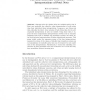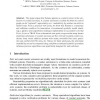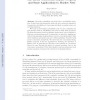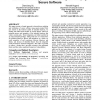109
click to vote
FASE
2005
Springer
15 years 6 months ago
2005
Springer
This paper is concerned with the application of Web services to distributed, cross-organizational business processes. In this scenario, it is crucial to answer the following questi...
118
click to vote
EMSOFT
2005
Springer
15 years 6 months ago
2005
Springer
We describe a system as a set of communicating concurrent programs. Quasi-static scheduling compiles the concurrent programs into a sequential one. It uses a Petri net as an inter...
106
click to vote
CONCUR
2005
Springer
15 years 6 months ago
2005
Springer
Starting from the opinion that the standard firing rule of Petri nets embodies the collective token interpretation of nets rather than their individual token interpretation, I pro...
BPM
2005
Springer
15 years 6 months ago
2005
Springer
We present a Petri net semantics for the Business Process Execution Language for Web Services (BPEL). Our semantics covers the standard behaviour of BPEL as well as the exceptional...
104
Voted
ATVA
2005
Springer
15 years 6 months ago
2005
Springer
Abstract. This paper argues that flatness appears as a central notion in the verification of counter automata. A counter automaton is called flat when its control graph can be �...
92
Voted
ATAL
2005
Springer
15 years 6 months ago
2005
Springer
This paper focuses on a framework for representing a team plan and its projections on individual agents. The team plan is represented with a coloured Petri net. Using the implicit...
105
click to vote
APN
2005
Springer
15 years 6 months ago
2005
Springer
STGs give a formalism for the description of asynchronous circuits based on Petri nets. To overcome the state explosion problem one may encounter during circuit synthesis, a nondet...
105
click to vote
APN
2005
Springer
15 years 6 months ago
2005
Springer
Abstract. We study probabilistic safe Petri nets, a probabilistic extension of safe Petri nets interpreted under the true-concurrent semantics. In particular, the likelihood of pro...
84
Voted
AOSE
2005
Springer
15 years 6 months ago
2005
Springer
Interactions between agents are traditionally specified as interaction protocols using notations such as Petri nets, AUML, or finite state machines. These protocols are a poor �...
108
Voted
KBSE
2005
IEEE
15 years 6 months ago
2005
IEEE
This paper presents a formal approach to threat-driven modeling and verification of secure software using aspect-oriented Petri nets. Based on the behavior model of intended funct...




